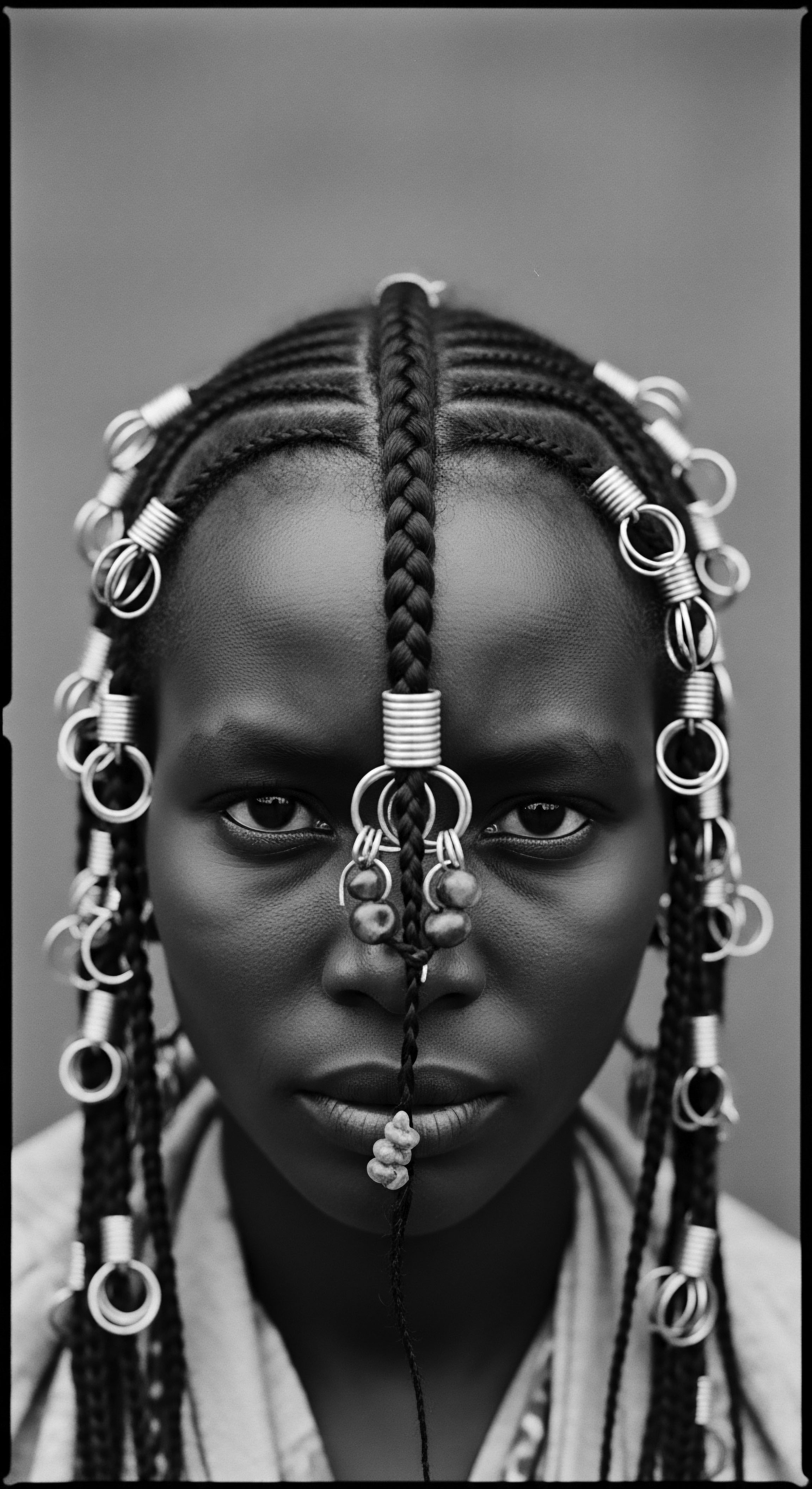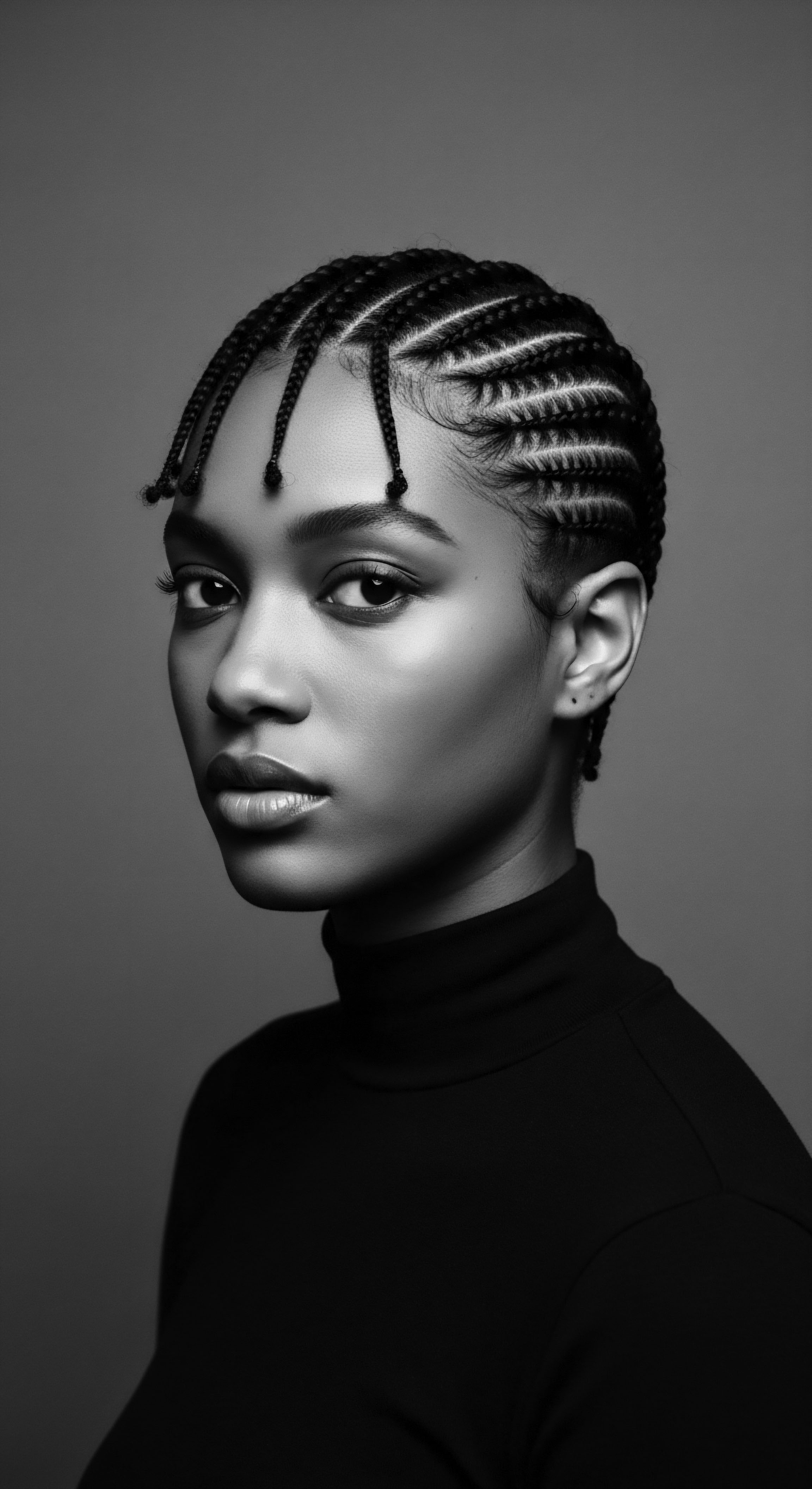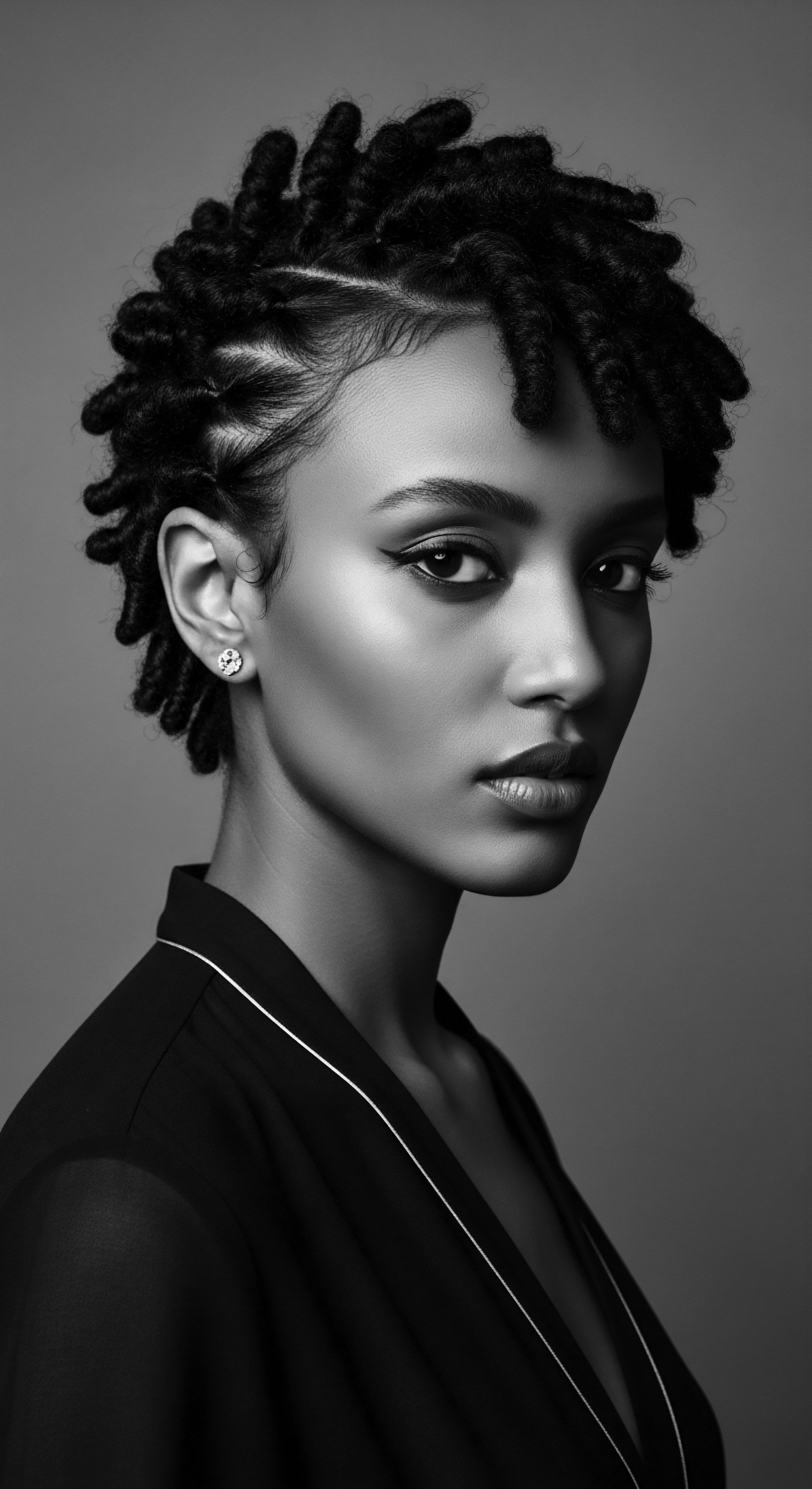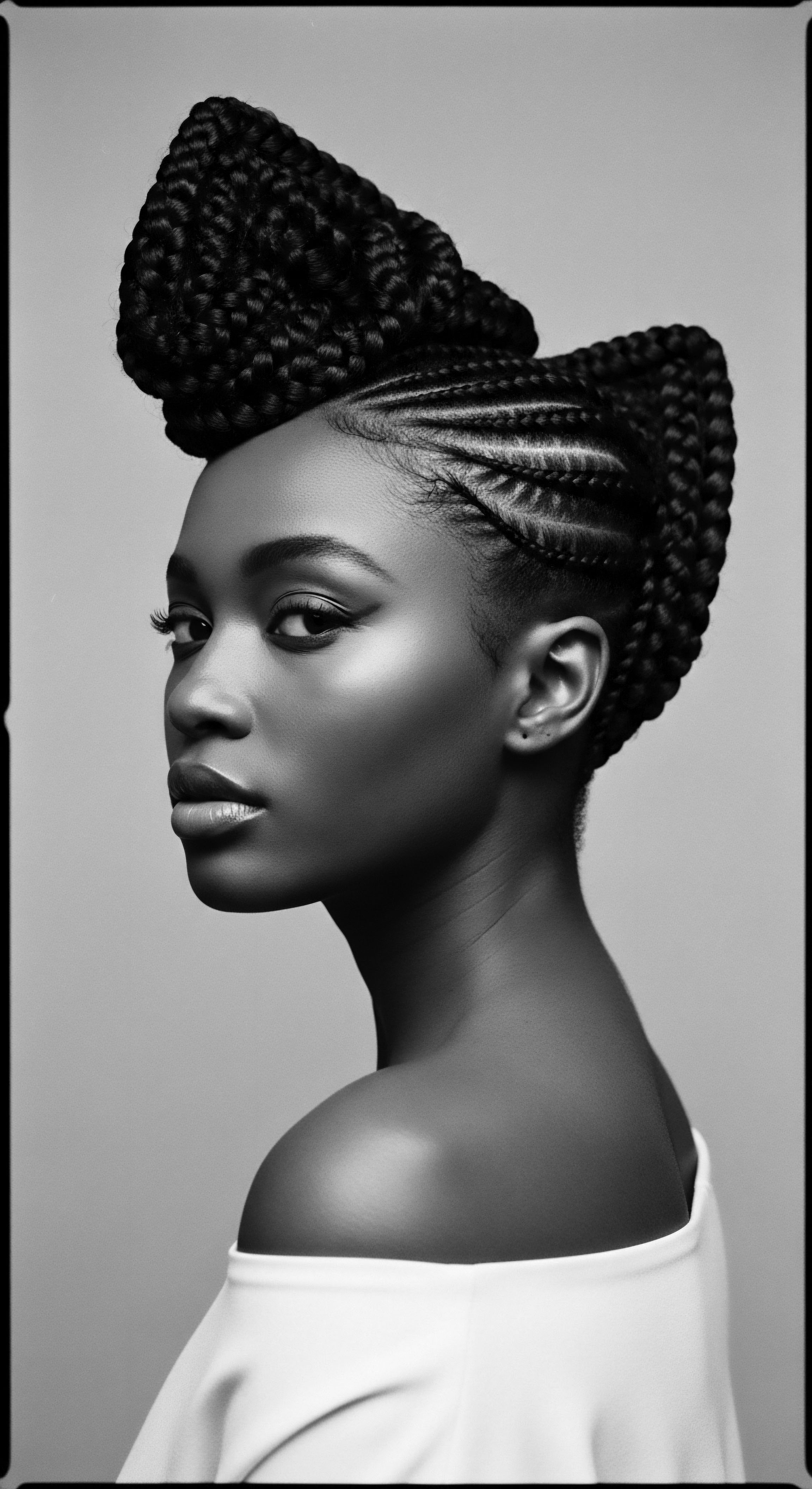
Roots
When we speak of textured hair, we embark upon a journey that reaches back through the mists of time, touching shores where the very structure of a strand held deep meaning. This exploration is not a mere recitation of facts; it is an invitation to feel the pulse of ancestral wisdom, to comprehend how ancient practices laid the groundwork for the styling methods we cherish today. From the elemental biology of the hair follicle to the intricate patterns seen in archaeological records, the heritage of textured hair is a living current that shapes our present understanding. It asks us to consider how our hands, in tending to curls and coils, echo the hands of those who came before us, connecting us to a collective memory written in every twist and turn of the hair itself.

Hair’s Ancestral Architecture
The unique architecture of textured hair—its elliptical cross-section, the varying degrees of curl, and the distribution of disulfide bonds—is not simply a biological marvel; it is a legacy. Each tightly coiled helix or softly undulating wave tells a story of adaptation to diverse environments, from the scorching sun of ancient African plains to the varied climates of diasporic lands. Scientific inquiry now confirms the incredible resilience and inherent strength of these unique hair forms, attributes that ancient communities understood intuitively. Our ancestors, keenly observing the interplay of environment and natural hair, developed profound insights into its care.
They recognized its distinct needs for moisture retention and its capacity for protective shaping. This foundational knowledge, passed down through generations, predates modern trichology, yet its principles remain profoundly relevant.
Understanding the hair shaft’s cuticle scales, its cortical cells, and the medullary core helps us grasp why certain historical care practices were so effective. The way these scales lie, for instance, influences how light reflects and how moisture is retained—a challenge for highly curled hair, prompting ancestral solutions like rich botanical oils and butters to seal in hydration. The very act of braiding or twisting hair into a protective style inherently recognizes the fragile nature of the outermost cuticle layer, safeguarding it from environmental stressors.

Decoding Hair’s Cultural Classifications
Centuries before contemporary classification systems emerged, African societies possessed their own intricate lexicons for hair. These systems transcended mere texture, instead describing hair in relation to personal identity, community roles, and spiritual connection. A particular braid pattern, for instance, might signal marital status, age, or tribal affiliation. The language used to describe hair was alive, drawing from nature, community, and the human condition.
The deep historical understanding of textured hair’s diverse forms reveals a nuanced connection between biology and communal identity.
Modern classifications, while useful for scientific study and product development, sometimes fall short in capturing this depth of cultural meaning. They categorize based on curl pattern, density, and strand width. While these objective measures are important for prescriptive care, they rarely encompass the symbolic weight hair carried within ancestral traditions.
The challenge, then, for contemporary approaches, lies in honoring both the scientific understanding of hair and the rich, multi-layered cultural context that has always surrounded it. This involves acknowledging the biases embedded in some historical Western beauty standards that often marginalized textured hair, and consciously seeking to reclaim and celebrate its innate splendor.

A Lexicon of Legacy
The language surrounding textured hair today carries echoes of its deep past. Terms like “locs,” “braids,” “twists,” and “coils” are not merely descriptive; they carry cultural weight, representing techniques and styles with historical lineages. Many of these terms have equivalents or direct descendants in various African languages and Creole dialects. For instance, the term “cornrows” likely comes from the resemblance of braided rows to fields of corn, a visual metaphor that speaks to agricultural heritage.
An exploration into the deep past reveals how specific terms were associated with particular tools, ingredients, and social rituals. The very act of naming a style or a care practice was a way of preserving knowledge and connecting individuals to a larger communal story. Consider the vast terminology for different braiding techniques across African cultures, each with its own regional name and cultural significance (Omotoso, 2018). This linguistic richness mirrors the diversity of the hair itself and the ingenuity of those who cared for it.
- Kinky ❉ Often used to describe very tight, zig-zagging coils; historically pathologized, now reclaimed as a descriptor of unique texture.
- Protective Styles ❉ Techniques designed to shield hair ends and reduce manipulation, a practice with ancient roots in preserving hair health and length in harsh conditions.
- Crown ❉ A metaphorical term for the hair, particularly textured hair, elevating its status beyond mere strands to a symbol of regal power and spiritual connection, echoing traditional African beliefs about the head as a sacred space.

The Rhythms of Growth and Ancestral Influences
The cycles of hair growth—anagen, catagen, telogen—are universal biological processes. Yet, historical techniques often aligned with these natural rhythms, emphasizing care that supported hair during its active growth phase and minimized damage during its resting phase. Ancestral communities, without microscopes or biochemical analyses, observed the impact of diet, environment, and specific care practices on hair vitality. They understood, through generations of lived experience, that healthy hair was often a reflection of overall well-being.
Factors such as nutrition played a significant, if unquantified, role in hair health. Diets rich in traditional African staples—often nutrient-dense and unprocessed—would have provided the necessary building blocks for robust hair growth. Environmental factors also shaped care ❉ the need to protect hair from sun, dust, and arid conditions in some regions led to the adoption of headwraps, oils, and protective braiding styles, techniques that continue to shape contemporary approaches to guarding the hair shaft. This understanding of hair as intimately connected to one’s physical and environmental landscape is a profound piece of our heritage.

Ritual
From the hands of ancient African braiders to the skilled stylists of today, the artistry of textured hair has always transcended simple aesthetics. These practices, whether intricate cornrows or resilient locs, are not merely techniques; they are living rituals, steeped in cultural heritage and ancestral wisdom. They speak of community, communication, and a profound understanding of the hair’s inherent needs.
Many contemporary styling approaches for textured hair owe their fundamental principles and even their very forms to these deeply rooted historical practices. The ingenuity of our forebears, who shaped hair into declarations of identity, continues to guide our choices in the present.

Protective Styles from Ancient Roots
Protective styles stand as a powerful testament to the enduring legacy of textured hair care. These methods, designed to shield delicate ends and minimize daily manipulation, have a history as long as the hair itself. Archaeological findings and historical accounts reveal that styles like braids, twists, and coils were not just beautiful adornments in ancient African societies; they served as practical solutions for managing hair, preventing breakage, and maintaining scalp health in diverse climates (Omotoso, 2018). They acted as a shield against environmental elements and daily wear, allowing for length retention.
The complexity of these styles often communicated a visual language. For example, during the 15th century, certain African people, including the Wolof, Mende, Mandingo, and Yoruba, used specific braiding patterns as a means to convey messages, acting as a form of communication within communities (Omotoso, 2018; Byrd & Tharps, 2001). During the transatlantic slave trade, this ingenuity took on an even deeper meaning, with some enslaved Africans encoding escape route maps and hiding spots for seeds or small tools within their cornrow patterns, transforming hair into a literal tool of survival and resistance. This profound aspect of textured hair heritage underscores that these styles carry stories of resilience and identity that extend far beyond their visual appeal.
Today’s box braids, cornrows, and twists are direct descendants of these ancestral techniques. While modern iterations might incorporate synthetic hair for added length or volume, the core principles of sectioning, intertwining, and protecting remain unchanged, a continuous thread of heritage spanning millennia.
The practical and symbolic power of protective styling, passed down through generations, remains a cornerstone of textured hair care.

Defining Natural Forms with Traditional Methods
The quest for definition and shape in textured hair is not a recent phenomenon. Historical communities celebrated the natural curl and coil patterns, developing methods to enhance and maintain their distinct forms. Techniques that are now termed “wash-and-gos” or “twist-outs” have conceptual roots in traditional practices where hydration, careful detangling, and specific manipulation encouraged the hair’s natural grouping.
Ancient African societies used a variety of natural substances and hands-on methods to achieve desired looks. Plant-based gels from ingredients like hibiscus or flaxseed, along with rich shea butter and various oils, were applied to define curls and add sheen. The fingers, the most fundamental tool, worked with the hair’s natural inclinations, gently coaxing patterns into being. This deliberate, often slow, process fostered a deep connection to one’s hair, treating it not as something to be subdued but as a living canvas to be honored.

How Did Ancestral Adornment Shape Modern Hair Extensions?
The use of supplemental hair for volume, length, or elaborate styling is not a contemporary invention. Wigs and hair extensions hold a place in human history, with particularly rich applications in ancient African societies, notably ancient Egypt and Kush. These adornments served as powerful markers of status, wealth, and spiritual belief.
Elaborate wigs crafted from human hair, plant fibers, and even wool, often adorned with precious metals and jewels, were worn by the elite. The Kushites, for instance, valued tight, coiled braids and headpieces decorated with jewels, feathers, and metals, reflecting both tribal identity and religious beliefs.
The historical record suggests these were not merely for disguise but for enhancement, a way to display power and connection to the divine. Today’s wigs and extensions, while technologically advanced, echo this ancient desire for transformation and expression. The spirit of ancestral adornment, whether for ceremonial purposes or daily display, continues to influence the global popularity of these styling options.

Heat Styling’s Historical Nuances
While modern heat styling tools like flat irons and curling wands are relatively new, the concept of altering hair texture through heat has historical precedents, albeit with different methods and motivations. Traditional African communities often used heated combs or instruments crafted from natural materials, not for wholesale straightening, but for specific purposes like stretching hair to make it more manageable for braiding or creating sleek parts. These tools were usually made of metal or bone and gently warmed over a fire, then carefully applied.
The primary goal was often manipulation for ease of styling or scalp access, not necessarily a fundamental alteration of the hair’s natural curl pattern for a sustained period. This contrasts sharply with the contemporary desire for permanent texture changes. The cautious, often localized use of heat in ancestral practices provides a valuable lesson in balancing desired effects with hair health, a principle that remains paramount in safe heat styling today.

The Tools of the Heritage
The toolkit for textured hair care has always been deeply intertwined with available natural resources and cultural ingenuity. From intricately carved combs to simple natural fibers, each tool served a specific purpose in nurturing and styling.
| Historical Tool Wide-Tooth Comb |
| Description and Ancestral Use Carved from wood or bone, used for gentle detangling, particularly on dry or pre-oiled hair, preserving the hair's natural state. |
| Contemporary Parallel/Influence Plastic or silicone wide-tooth combs, designed to minimize breakage on wet or dry textured hair, continuing the tradition of gentle detangling. |
| Historical Tool Fingers |
| Description and Ancestral Use The primary and most essential tool, used for sectioning, twisting, braiding, and applying oils, allowing for precise and sensitive hair manipulation. |
| Contemporary Parallel/Influence "Finger detangling" and "finger coiling" methods, emphasizing minimal manipulation and respecting the hair's natural curl grouping. |
| Historical Tool Plant Fibers/Leaves |
| Description and Ancestral Use Used as binding agents for braids or to create natural hair accessories and decorative elements. |
| Contemporary Parallel/Influence Hair ties, elastic bands, and decorative hair jewels used in braids, twists, and updos, continuing the tradition of adornment and secure styling. |
| Historical Tool Heated Metal/Bone Rods |
| Description and Ancestral Use Gently warmed and used for stretching sections of hair before braiding or creating smooth parts, not for permanent alteration. |
| Contemporary Parallel/Influence Thermal combs or flat irons, used cautiously for stretching or temporary smoothing of textured hair, requiring careful temperature control to avoid damage. |
| Historical Tool These tools, both ancient and new, demonstrate an ongoing commitment to understanding and honoring textured hair. |
The simple act of using one’s fingers to detangle and style, a practice common in many traditional communities, remains the most gentle method for maintaining hair integrity. This heritage of mindful manipulation, combined with the practical application of tools born from necessity and creativity, continues to define effective styling for textured hair today.

Relay
The daily regimen of textured hair care is a relay race across generations, each hand passing down wisdom, adaptation, and unwavering devotion to the strands. Modern holistic care and problem-solving approaches for textured hair are deeply informed by ancestral wisdom, often validating traditional practices through contemporary scientific understanding. This ongoing exchange between past and present creates a rich tapestry of care that addresses the whole person, recognizing hair as an extension of well-being and a profound connection to heritage.

Crafting Personalized Regimens from Shared Wisdom
The concept of a “personalized hair regimen” might seem modern, yet its roots lie in ancestral practices that inherently understood individual needs. Communities often shared general knowledge about herbs, oils, and techniques, but mothers, grandmothers, and community elders adapted these practices to suit the specific hair type, lifestyle, and environmental conditions of each person. This bespoke approach was a hallmark of traditional hair care, recognizing that hair, like identity, is deeply individual.
Ancestral wisdom emphasized listening to the hair, observing its response to different ingredients and manipulations. This intuitive understanding, passed down through oral traditions and hands-on teaching, forms the bedrock of today’s personalized routines. Modern science now quantifies this, speaking of porosity, density, and elasticity.
The blend of this scientific rigor with the heritage of intuitive care allows for truly tailored approaches that honor both the hair’s biological needs and its unique cultural history. For instance, the use of fermented rice water for hair growth, a practice with ancient Asian and African roots, is now explored by scientists for its potential amino acid content and scalp benefits, bridging millennia of wisdom with contemporary validation.

The Nighttime Sanctuary and Bonnet’s Legacy
The protection of textured hair during sleep is a practice with a long and significant heritage, particularly within Black and mixed-race communities. Before the advent of silk or satin bonnets, head coverings made from natural fibers were used to protect intricate styles and maintain moisture. These coverings were not just about preserving a hairstyle; they were part of a ritual of self-care, a way to honor the hair as a sacred extension of the self. The head, considered the most elevated part of the body and a spiritual entry point in many African cultures, received special attention and protection.
The bonnet, in its modern iteration, carries this ancestral legacy. It safeguards curls and coils from friction against absorbent fabrics, preventing tangles and moisture loss. Its widespread adoption speaks to a collective understanding of textured hair’s delicate nature and the shared experience of preserving its integrity. This seemingly simple accessory is a direct link to a heritage of protective practices, born from a deep respect for the hair’s well-being.
Daily and nightly hair rituals are a continuation of ancestral practices, ensuring moisture retention and safeguarding the hair’s intricate forms.

Ingredients as Ancestral Remedies
The ingredients that nourish textured hair today often mirror those used by our ancestors for centuries. The earth’s bounty provided a natural pharmacy for hair health, with various plants, oils, and minerals playing roles in cleansing, conditioning, and strengthening.
- Shea Butter ❉ Derived from the nuts of the African shea tree, this rich butter has been a staple for millennia. Its emollient properties made it ideal for sealing in moisture, softening hair, and protecting against environmental harshness. Today, it remains a cornerstone in many textured hair formulations for its deeply conditioning effects.
- Coconut Oil ❉ Widely used in West African and Caribbean traditions, coconut oil was valued for its penetrating abilities, providing lubrication to the hair shaft and scalp. Its continued popularity reflects a long-standing appreciation for its nourishing qualities.
- African Black Soap ❉ Traditionally made from plantain skins, cocoa pods, and shea tree bark, this natural cleanser gently purified the scalp without stripping its vital oils. Its heritage as a mild yet effective cleansing agent continues to guide formulations seeking gentle cleansing for textured hair.
The efficacy of these traditional ingredients, once understood through empirical observation and passed-down knowledge, is now often validated by scientific research into their biochemical compositions. This convergence of ancient wisdom and modern inquiry highlights the enduring power of these ancestral remedies.

Addressing Hair Challenges Through Time
Hair challenges are not new; our ancestors faced issues like dryness, breakage, and scalp irritation, developing ingenious solutions rooted in their environment and communal knowledge. Contemporary problem-solving for textured hair often draws directly from these heritage practices.
| Hair Challenge Dryness and Brittleness |
| Ancestral Solution/Technique Regular application of rich plant oils (e.g. palm, castor) and butters (e.g. shea, cocoa) to seal moisture and provide a protective barrier. |
| Contemporary Approach (Informed by Heritage) Layering products using the "LOC" (Liquid, Oil, Cream) method or similar routines to maximize hydration and moisture retention. |
| Hair Challenge Tangles and Knots |
| Ancestral Solution/Technique Finger detangling, precise sectioning before washing, and using wide-tooth implements often carved from wood or bone. |
| Contemporary Approach (Informed by Heritage) Pre-pooing with oils, using wide-tooth combs or detangling brushes, and detangling hair while wet and saturated with conditioner. |
| Hair Challenge Scalp Irritation/Dandruff |
| Ancestral Solution/Technique Application of herbal infusions (e.g. neem, aloe vera) or natural clays with anti-inflammatory properties, coupled with gentle cleansing. |
| Contemporary Approach (Informed by Heritage) Using sulfate-free shampoos and conditioners with soothing ingredients, practicing scalp massages, and incorporating specific essential oils. |
| Hair Challenge The ingenuity of ancestral problem-solving continues to provide foundational strategies for textured hair health today. |
The wisdom was not about quick fixes, but about consistent, gentle care that honored the hair’s natural inclinations. This deep-seated approach, prioritizing patience and natural remedies, continues to shape effective, long-term solutions for common textured hair concerns.

Holistic Well-Being and Hair’s Interconnectedness
Ancestral philosophies often viewed hair not in isolation, but as an integral part of holistic well-being, connected to spirit, community, and the earth. Hair was seen as a barometer of health, with its condition reflecting one’s inner state. This perspective meant that hair care was intertwined with broader wellness practices, including nourishing diets, spiritual rituals, and communal bonding.
The act of hair braiding, for example, was frequently a communal activity, involving storytelling, wisdom sharing, and spiritual connection between generations. This ritualistic aspect emphasized the social and spiritual dimensions of hair care, acknowledging its role in strengthening familial bonds and preserving cultural identity. Today, the growing interest in “holistic hair care” echoes this ancient understanding, recognizing that external treatments are most effective when supported by internal health and a sense of connection to one’s heritage and community.

Reflection
The journey through the historical techniques that continue to shape contemporary styling approaches for textured hair is a profound meditation on endurance. It is a story whispered across continents and through generations, a legacy etched into the very helix of each strand. Our textured hair, in its myriad forms, carries the echoes of ancient hands, the resilience forged in adversity, and the vibrant declarations of identity. The patterns we adorn, the tools we use, the ingredients we apply—these are not inventions of the modern age, but rather conscious or unconscious continuations of an ancestral dialogue.
To truly understand textured hair is to see it as a living archive, each curl and coil holding a fragment of collective memory, a testament to ingenuity, and an assertion of self. The ‘Soul of a Strand’ ethos reminds us that care for this heritage extends beyond superficial beauty; it is a sacred practice, a reconnection to roots that run deeper than any product or trend. In every twist, every braid, every nurtured coil, we honor a continuous, unbroken line of wisdom, ensuring that the legacy of textured hair continues to shape futures as profoundly as it has shaped our past.

References
- Omotoso, Sharon Adetutu. “Gender and Hair Politics ❉ An African Philosophical Analysis.” Journal of Pan African Studies, vol. 11, no. 1, 2018.
- Byrd, Ayana, and Lori Tharps. Hair Story ❉ Untangling the Roots of Black Hair in America. St. Martin’s Press, 2001.
- Banks, Ingrid. Hair Matters ❉ Beauty, Power, and Black Women’s Consciousness. New York University Press, 2000.
- Patton, Tracey. African American Hair Culture. Routledge, 2006.
- Mercer, Kobena. Welcome to the Jungle ❉ New Positions in Cultural Studies. Routledge, 1994.
- Akbar, Na’im. Visions for Black Men. Mind Productions & Associates, 1991.
